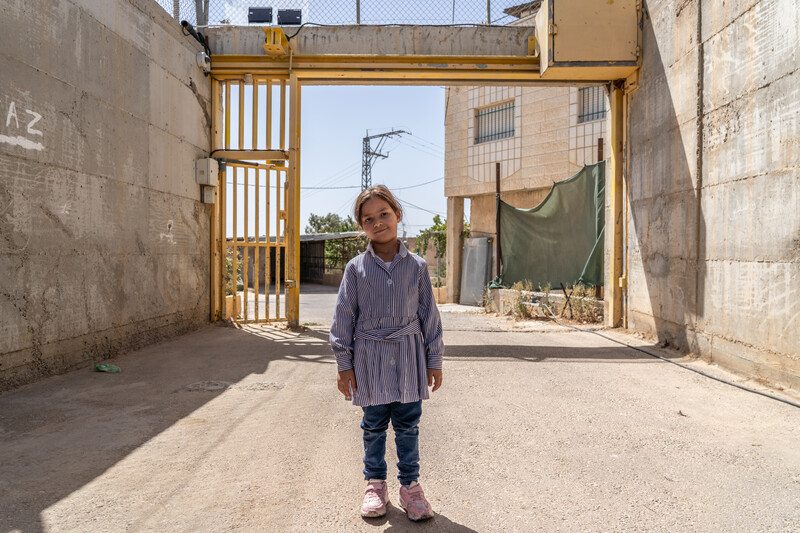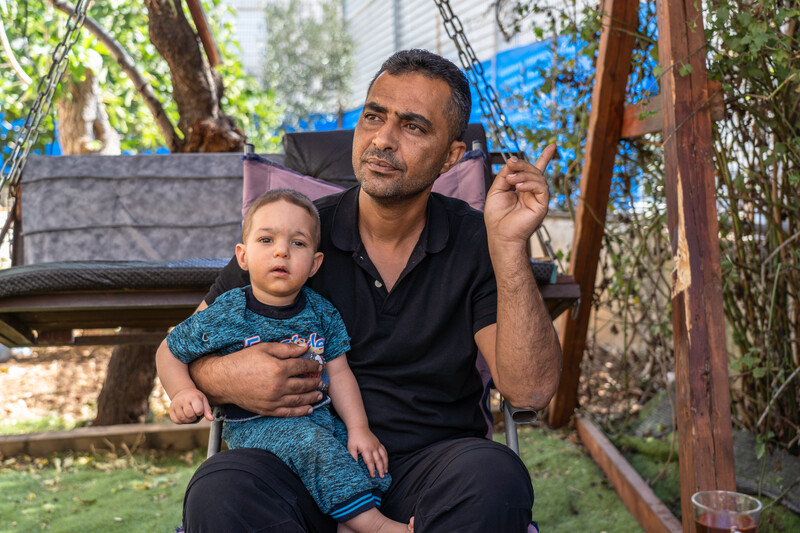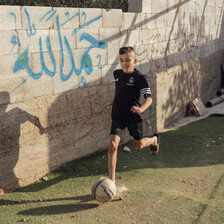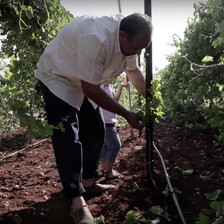The Electronic Intifada 23 November 2022

Haya, 6, stands before the Israeli-installed metal gate that is the only entry and exit for the Gharib family to and from their home.
Sakina al-Gharib, 74, remembers when she first moved into her white stone house. It was more than 40 years ago, soon after marrying her husband Sabri, who died in 2012.
Nestled on a hilltop near their occupied West Bank village of Beit Ijza – just north of Jerusalem – Sakina would wake up each morning and look out at the rolling hills of olive trees lighting up under the rising sun.
“We were the only family on this hilltop,” Sakina told The Electronic Intifada. “It was very quiet and peaceful. We used to be able to see the Mediterranean Sea from here. It was the perfect place to raise our children.”
The family built this home in 1979 on 100,000 square meters of land, which has been in their possession since Ottoman times.
Now, however, Israel has confiscated almost all their land and their home is surrounded by an eight-meter high iron fence. The hills of olive trees have been replaced by villas – two or three stories high – built for Israelis settling in the area in violation of international law.
“We are in a constant state of fear and insecurity,” Sakina said. “We feel like at any moment Israeli soldiers can come and arrest us or destroy our home. It’s like we are living in a prison.”
Decades of confiscations
There is just one entrance to the Gharib family’s home, with a cement corridor giving way to a tall iron barrier separating the family from the Israeli settlement surrounding them.
Cameras are pointed at the entrance of the family’s home, a gated structure of cement and fencing. More are mounted on their Israeli neighbors’ homes, facing the Gharib family’s one-story house.
The iron fencing around the Gharib family within the ever-growing Israeli settlement surrounding them is just one part of the labyrinth of fences, bypass roads – there’s even a tunnel – that sever access to their lands in this area.
On the way to the family’s home, driving through Beit Ijza’s village center, posters and large banners displaying the image of 36-year-old Muhammad Awad are pasted on shop windows and draped across homes.
Awad was a teacher and father of three who was shot and killed by Israeli soldiers in September. The tributes to him are visible reminders of the army and settler violence that has shaped the lives of Palestinians in this village over several decades.
According to Saadat Gharib, Sakina’s 41-year-old son, Israel began the process of confiscating the family’s land almost immediately after his parents built the home. In 1979 – 12 years after Israel took control of the West Bank following the 1967 Six-Day War – makeshift containers had already been erected near the family’s lands, where a few Israeli settlers established themselves.
The settlers would at times approach Saadat’s father, Sabri, with requests to buy parts of the land, offers he promptly refused.
“They offered him a lot of money,” Saadat said. “But my father consistently told them that this land was not for sale. All the Israeli money in the world would not be enough to buy even a meter of this land… And then the drama soon began.”
In 1983, the Givon Hahadasha settlement was established and the Israeli government attempted to confiscate 25,000 square meters of the family’s land. The case went to Israel’s high court, but in 1993 this was postponed after the Oslo accords were signed by the Palestine Liberation Organization and Israel.
The Oslo agreements established the administrative division of the West Bank into areas A, B, and C as a transitional arrangement, pending a final status agreement. Area C, which makes up more than 60 percent of the West Bank, was put under full Israeli control.
Despite granting the PA control over administrative and internal security matters in parts of the West Bank, Israel maintains ultimate military control over the entire area.
The Oslo agreements were meant to set the stage for peace talks brokered by the United States, with the objective of negotiating a two-state solution. Instead, they left Israel in complete control of the Palestinian economy.
Victims of Oslo
Israel has since rapidly expanded its settlements throughout Area C of the West Bank.
In 1993, the year the Oslo accords were signed, the population of Israeli settlers in the West Bank – excluding occupied East Jerusalem – was 116,300. Now, the number of Israeli settlers has exploded to more than 465,000 – with a further 230,000 Jewish settlers in occupied East Jerusalem.
Through the Oslo negotiations, the Israeli government was able to confiscate 168,000 square meters of Beit Ijza’s land, about 6.5 percent of the total village area to make more room for the Givat Zeev and Givon Hahadasha settlements.
Part of the Gharib family’s land, about 40,000 square meters, was a site where Jews had briefly lived in the 1920s. After 1948, and after Israel was established upon the displacement and expulsion of more than 750,000 Palestinians, the land became Jordanian government property.
In 1967, after Israel’s military takeover of the West Bank and Gaza, it was declared Israeli government property.

View from a cage.
According to Saadat, his late father Sabri traveled to Gaza three times to meet Yasser Arafat, then chair of the PLO, to plead with the leader to protect his land from Israeli confiscation during the Oslo negotiations. In the end, the 40,000 square meters where the family had managed a small farm growing wheat and barley, was simply confiscated by Israel – bringing an end to the protracted court proceedings.
Over the years, the Gharib family has been squeezed onto a tiny piece of their land, measuring just 400 square meters. The Israeli settler population of Givon Hahadasha has grown to 1,250.
With Givat Zeev, the other settlement in the area, the total number of settlers is some 12,000.
In 2002, during the second Palestinian intifada, Israel began constructing the separation wall, the total length of which is expected to be 712km upon completion. According to the Israeli rights group B’Tselem, 85 percent of the wall is being built inside occupied Palestinian territory, leading many to conclude that its construction has little to do with security and is instead aimed at annexing more land.
According to Saadat, owing to protests and a battle in the Israeli courts, the village was able to freeze the wall’s construction in Beit Ijza until 2005, at which point the building work resumed.
According to rights groups, the wall extends two kilometers onto Beit Ijza’s lands and isolates 980,000 square meters of the eastern part of the village on the Israeli side of the barrier.
Frosty relations
When Israel’s wall reached the Gharib family’s home at the end of 2006, around 100 Israeli soldiers also arrived. After prolonged confrontations between the family and soldiers, Sabri, who was then in his 70s, along with Saadat and his brother, who were both in their 20s, were arrested.
Sabri had a stroke during the ordeal, his health taking a turn for the worse.
The men were released after six months to find their home surrounded on three sides by a one-meter high cement wall and tall iron fencing, eight meters high. The enclosure only has one narrow passage out to the village center and neighboring Palestinian communities.
“I felt so much pain when I saw the enclosure,” Saadat said, the youngest of his four children, Muhammad, 1, straddled on his lap. “I also felt anger because you cannot do anything about what is happening to you. We don’t have a big army like them to protect us. We are powerless against these injustices happening to us.”
In addition to being enclosed into a fenced-in enclave, bordered by rows of Israeli settler homes, the 60,000 square meters of the rest of the family’s 100,000 square meters piece of land also ended up on the Israeli side of the wall.
For generations, the Gharib family had planted grapes and olive trees on this land. They can now only access it for a few days each year for grape harvesting and olive picking – and only with an Israeli army permit.
Years ago, one of their Israeli neighbors would harass the family, standing naked outside his balcony that overlooks the Gharib family’s home when women and girls were outside, “knowing that something like this is shameful in our culture,” Saadat said.

Saadat Gharib with his youngest child, Muhammad, 1.
The Israeli neighbor would also loudly curse the Prophet Muhammad each time the adhan, or the Muslim call to prayer, could be heard coming from the village mosque’s loudspeakers. This neighbor has since moved.
Other than this, “we have no interactions with these Israelis,” said Saadat, as an Israeli woman exited her house adjacent to his. On the other side of the crisscrossed iron fence encircling the Gharib family’s home, the woman began to water a line of flower pots.
“I refuse to even look them in their faces,” Saadat added. “I don’t know their names or where they come from. All I know is they stole our land and our freedom.”
A few times, settlers have attempted to greet Saadat, but “I never respond to them,” he said. “I don’t accept any pleasantries.”
The family has draped a blue sheet along the lengths of the iron barrier, to provide a semblance of privacy from the bizarre realities defining their lives.
“Sometimes I look up at their houses and wonder how they can live like this – each day waking up and seeing this injustice they caused – putting a family into a cage on their own land. I feel ashamed for them.”
Total control
For three months following the construction of the barrier around their home, the Israeli army controlled the only entrance into the cage that the Gharib family have now been condemned to.
“It was the hardest three months of my life,” Saadat said.
The entrance was equipped with cameras and an intercom system. Any time the family wanted to leave the premises they would need the International Committee of the Red Cross to intervene.
This coincided with the family having to take Sabri almost every day to a hospital to receive treatment following his stroke.
“The soldiers would see us in the cameras and they could hear us,” Saadat said. “And they would still make us stand outside, sometimes for two or three hours, before they opened the gate.”
Three months later, however, Israel’s high court ruled that the entrance to the Gharib family’s home should be open 24 hours a day. But the Israeli army still possesses the key to the only door between the family and the rest of their village.
Soldiers can lock the entrance at any time. And they often do when tensions rise in the area or confrontations erupt between Palestinians and the Israeli army or settlers around Beit Ijza.
The 60,000 square meters he still owns, but are now located on the Israeli side of the wall, are also slowly being ripped from his grip. During the October olive harvest, Palestinian landowners are supposed to be allowed access to their lands from 7 am until 4 pm.
In reality, however, “the soldiers will open the gate in the barrier sometimes at 9:30, sometimes at 10:30,” Saadat explained. “Then they check our IDs and by the time they finish their security checks another hour has passed.”
The gate the Palestinian farmers must pass through to reach their land is an hour’s walk from the Gharib family’s home. If it was not for Israel’s wall, it would take just two minutes to walk from their home to their lands.
“Often we can’t harvest all the olives during that amount of time, even if I have my relatives helping me,” Saadat said. “It’s just impossible.”
“It’s a very hard life,” he told The Electronic Intifada. “I am frightened and scared for my children. Even the land I still own, the Israelis have made it so I can’t do anything with it. The settlers and army control every aspect of our lives. They watch every single step we make – as if it is a crime to live on your own land.”
Tough place for children
Saadat’s children are growing up in this highly unusual environment.
“If it’s night time and I need to leave the house, my children cry and beg me not to leave. They are scared that the settlers might do something to them,” Saadat said. “How can I explain to my children why the Israeli children have green spaces to play, but all we have is this small besieged piece of land?”
Just six months earlier, his two sons and a nephew – all under the age of 10 – were playing football together on the pavement between the fences that tower above them. They accidently kicked the football onto the settlement’s side of the wall and in just five minutes Israeli army jeeps pulled up to the family’s home.
The children’s wrists were tied with zip ties and they were transported to an Israeli police station at the nearby Atarot industrial zone, where they were interrogated for six hours.
“They were frightened for a long time after this,” Saadat said. But the most affected is his daughter Haya, 6, who has developed increasing anxiety since last year during Ramadan, when confrontations erupted with settlers around the village.
According to Saadat, about 20-25 Israeli settlers crowded around his home, chanting “death to Arabs.”
While we were talking, Haya came skipping down the thin stretch of pavement towards her family’s home on her way back from school. She immediately threw off her small pink backpack and played with her siblings.
They stuck their fingers into the surrounding iron fence and climbed on it. Saadat immediately yelled for them to get down.
What does Haya think about her Israeli neighbors?
“I hate them,” she quickly retorted. “They make me feel frightened… because they all have guns.”
Saadat hopes that his children will eventually adapt to the situation like he did.
“I raise them to be strong and to have hope,” he said. “We have given our souls, blood and life to this land, so we must continue to live here no matter how hard it gets.”
“Our house is like a fork stabbing the Israeli system. It is a nuisance for the occupation. And we will continue to defend it. We live in the knowledge that no occupation can last forever and one day it will end and our rights will be returned to us.”
Jaclynn Ashly is a freelance journalist.





